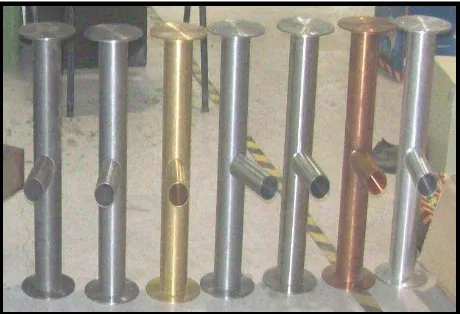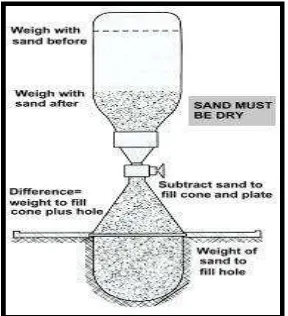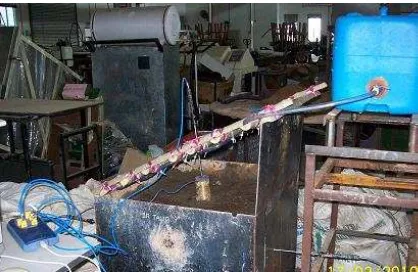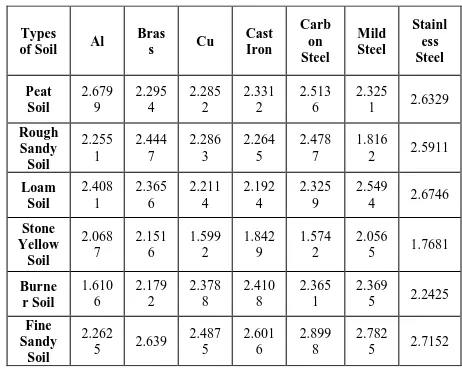Abstract:
The soil heat transfer characteristics are
important aspect when dealing with construction in contact with the soil. For example, in order to build a good cool and comfortable home, we should build it floors, walls and ceiling using highest conductivity materials internally and highest insulation material externally. This can also be applied for buried ducting in various type of soils. Buy knowing the thermal effects of the buried pipe, we can predict the consequence of burying different materials of pipe underneath different materials of soil. In this study, the thermal characteristics of various soil types i.e. sand, peat soil, loam soil, powdery soil as external material, combined with the metals i.e Aluminium, stainless steel, carbon steel, copper for internal materials. The test rig is designed such a way that the cross combinations of the above materials can be carried out easily. There are 5 types of soil thermal characteristics were studied in this research, they are peat soil, fine and course sandy soil, loam soil and organic soil. As example the combination of copper pipe with the porous soil or the combination of the carbon steel pipe underneath the lateritic soil. The test results show that with the increase of soil thermal conductivity, the heat in the metal ducting can be drained out faster to the earth hence cooling down the temperature in the ducting. From the thermal conductivity test for six types of soil using proctor test is peat soil and organic soil: 0.4499 W / (m.K), second is stone yellow soil: 0.4424 W / (m.K), following the loam soil: 0.4275 W / (m.K), fine sandy soil: 0.37019 W / (m.K) and coarse sandy soil: 0.349 W / (m.K). The thermal conductivity experiment of six type of soil via laboratory experiment is peat soil: 0.4699 W/mK,
organic soil: 0.4698W/mK, loam soil: 0.4535 W/mK, Lateritic soil: 0.4228W/mK, fine sandy soil: 0.3785W/mK and coarse sandy soil: 0.336W/mK. The above values were then used to design the
underground ducting cost-saving building
ventilation system using fluid mechanics principles
Keywords: soil heat transfer, soil thermal conductivity, earth cooling system, underground ventilation
,
metal-soil heat conduction, soil thermal characteristics.1. INTRODUCTION
Nowadays, large amount of energy is used for air conditioning system. Especially in china, it is up to 50%-70% of energy is used in air conditioning system. Therefore, the new design of the air cooling system to save the energy has to be developed. The system consists of underground buried pipe that covered with certain type of heat diffusing soil. For the sake of development of such system, the characteristics of soil heat transfer are needed to be studied. It is because the concept of cooling the air using earth cooled system is the most environmentally clean, energy-efficient and cost-efficient system.
In the study on heat transfer of buried pipe under the soil with standard thermal conductivity, the process of transmission of the heat into the soil with time and properties of soil is focused and narrowed down to a more useful application. Heat transfer test for buried pipe consist of convection between the fluid and the inside pipe wall, heat conduction trough the pipe wall, heat transfer and mass transfer outside pipe wall between the fields of soil.
THE STUDY ON THE SOIL HEAT TRANSFER CHARACTERISTICS
FOR THE DEVELOPMENT OF A COST-SAVING
UNDERGROUND AIR COOLING SYSTEM
Abdul Talib Din
1, Zairul Fazura
11
1.2 PROBLEM STATEMENT
The concept of design of an air conditioning system nowadays is easy to be installed and used. The basic components in air conditioning system are refrigeration, evaporator, condenser and expansion valve. However, if looking from health and environmental factor, the normal method of air conditioning system could not guarantee good healthy and clean environment. The reasons are that these air conditioning systems use chemical gas such as refrigeration likes R-22. In addition, this system needs more energy and power to generate the refrigerant pump and fan motor to move the inlet and outlet fan. The minimum power to generate the compressor is significantly high and this would result to significant vibration and of course power consumption. Furthermore, issues such as increasing ozone depletion potential and global warming due to the usage of refrigerant gases are critical. Based on these disadvantages, air conditioning system using earth cooling or dehumidification method is worth developed.
1.3 OBJECTIVE
The main objective of this research is to determine the thermal characteristic of the soils and the relationship of the heat transfer with the type and ingredient of the soil. Hence the specific objectives are:
i. To determine soil thermal conductivity using Proctor test
ii. To determine soil heat transfer characteristics of the soil using laboratory scaled experiment for various type of soils cross combined with various pipe materials.
iii. To obtain the relationship of temperature curve at 50mm, 100mm and 150mm bellow the center of buried cylindrical pipe and compare the data for each combined soil-pipe tested. iv. To study the characteristic of six types of soil
tested.
1.4 SCOPE OF THE RESEARCH
The data were obtained from both laboratory experiment and proctor test. The tests were carried out at Universiti Teknikal Malaysia Melaka (UTeM) R&D room. The tests involved six types of soil. It is fine sandy soil, rough sandy soil, stone yellow soil, organic soil, loam soil and peat soil. All types of soil were taken from various places in
Melaka State. The depth of the buried pipe is remained constant, which is 250mm from the surface of soil. The thickness and diameter of each pipe are also purposely made constant and the points of the temperature readings are at the same locations. The reading for thermometer is taken at one minute interval for a range of one minute to thirty minutes. The characteristics of soil are referred through the internet and also from previous and pass thesis by other researchers. The parameters recorded in the collection data is the points that the heat being propagate in the soil, temperature, time, type of pipe and the type of soil.
2. SOIL HEAT TRANSFER
Heat flow in soil may be determined from knowledge of the thermal conductivity and temperature gradient. The soil heat transfer is assumed to obey the following Fourier law of diffusion
where is the volumetric soil heat capacity
, is the soil temperature (units K), is the vertical coordinate-the distance from the
surface, positive downwards-(units m), and is
the thermal conductivity . The above
equation assumes that heat fluxes are predominantly in the vertical direction that the effects of phase changes in the soil and the heat transfer associated with the vertical movement of water in the soil can be neglected (de Vries 1975).
The formula involve thermal resistance model. The value of the thermal resistance for the different modes of heat transfer is calculated as the denominators of the developed equations. The thermal resistances of the different modes of heat transfer are used in analyzing combined modes of heat transfer. For this case of buried pipe in underground the formula will used cylinder theory models formula.
3. METHODOLOGY
The temperature are measured at five points. It is water temperature in pipe (T1), wall temperature inside the cylinder pipe(T2), wall temperature outside the cylinder pipe(T3), temperature at 50mm(T4), temperature at 100cm(T5) and 150mm (T6) from central of pipe in soil. The data obtained are used to calculate the soil heat transfer rate. The value of the soil heat transfer will be analyzed.
3.3 Soil Types and Material Pipe Characteristics
Six types of soil were chosen for laboratory test in the process to determine the soil heat transfer characteristics. They are sandy soil, loam soil and peat soil. Each soil have difference structure, organic, density and moisture contain. It is loam soil, peat soil, organic soil, yellow stone soil, fine and rough sandy soil. Seven cylindrical pipes made of different materials are used in experiment. It is aluminum, brass, cooper, cast iron, stainless steel, mild steel and carbon steel. It is important to select suitable material for buried pipe. In the fifties of the 20th century, the metal pipes are generally adopted, such as the zinc-plated steel and the copper pipes. Until later stage of the seventies, they are replaced by the silent stock pipes. Though the heat conduction performance of the silent stock pipe is worse than that of the metal, its thermal resistance is matched with that of soil well, and the anticorrosive performance is good, silent stock pipes are applied extensively. Table gives several commonly used pipes and their thermal conductivity
Figure 3.3: Different materials of hollow pipes.
Table 3.1: Material cylinder pipe properties (Source: The Engineering Toolbox, 2005)
Material
Thermal Conductivity (W/(m K))
Density p (g/cm3)
Specific Heat Cp (kJ/kg K)
Aluminum 204 2.7 0.91
Copper 386 8.92 0.39
Brass 109 8.525 0.38
Mild Steel 50 7.85 0.620
Carbon Steel
43 7.85 0.49
Stainless Steel
17 7.48 0.5
Cast Iron 55 6.8 0.46
3.4 Test Rig for the Soil Heat Transfer Experiment.
The above test rig is design in such a way that it is easy to fabricate and satisfy all the experiemntal requirements. The soil compartment is fabricated using mild steel of 6mm thickness. On each mild steel side wall, 0.7mm diameter holes are drilled at every 5cm interval. The dimension of cylinder pipe is 10cm x 50cm x 1cm.
Figure 3.4: Water dripping system to simulate the water existance in the soil.
3.5 Leakage Test of the Pipes
there is any leakage, put some heat resistance leakage gum or paste to stop the water from coming out from the pipe.
Figure 3.5: Showing that the area probability leakage for one sample of cylinder pipe.
3.6 Density test
Density and moisture is importance factor that influence the soil heat transfer. Sand Cone Test (ASTM D1556-90) is used to determine the density of soil. Dry density (Pd) is the mass of the dry soil contained in unit volume of under material. Bulk density (P) is the mass of material (including solid particles and any contained water) per unit volume including voids.
Figure 3.5. Illustration of Sand Cone Test
Figure 3.6 Sand cone test component and compact component
3.7 Moisture test
Moisture content (w) can be removed from the soil, usually by heating at 105 °C, expressed as a percentage of the dry mass. The term water content is also widely used. Calculate the moisture content of the soil specimen, w, as a percentage of the dry soil mass to the nearest 0.1 %,
From the equation:
w = (w2-w3)/ (w3-w1)x 100% where
w1 is the mass of container (in g),
w2 is the mass of container and wet soil (in g), w3 is the mass of container and dry soil (in g),
3.8 Soil Heat Transfer Test
Figure 3.7: Test Rig to used for experiment
The soil thermal conductivity is determined by using the equation below;
λ s = 0.144166 x [0.9 x long (n x 100) – 0.2] x 10
0.000024 P s in W/(m·K) unit,
where;
n denotes soil moisture (kg/kg);
ρs is density of soil, kg/m3
Then, using the Forier law formula to find the heat transfer of soil.
Q heat transfre = (T0 –T ∞ ) / R total
Were;
Q is heat transfer of soil
ΔT is difference of temperature
h is heat transfer coefficient
A is area of the hot water in cylinder pipe r 1 is radius inter hollow cylinder
r 2 is radius outer hollow cylinder
K1 is thermal conductivity of the cylinder pipe
A 1 is area of the cylinder pipe It is temperature at 50mm, 100mm and 150mm depth of soil. The temperature difference is between 50 mm and 100mm will determine the rate of heat transfer at the distance of 50mm.
Figure 4.1 Temperature difference curves for a sample of combination of soil-ducting material at 150mm soil depths
Soil Heat transfer is obtained using laboratory test. Each type of soil is test using seven types of pipe material. The data of the temperature at initial and final temperate after 30 minute were recorded. The differences of temperature divided by total resistance of the pipe and soil, gives the heat transfer rate. The samples of calculation of the soil heat transfer are shown in appendix.
sandy soil: 0.37019 W / (m.K) and rough sandy soil: 0.349 W / (m.K)
.
From the table above, the ideal value of dry density, maximum moisture content and thermal conductivity is rough sandy soil: 0.992 Mg/m3 ;4.7%; 0.336W/mK, peat soil: 0.972 Mg/ m3 ; 45.11%; has the higher dry density than rough sandy soil, peat soil, organic soil, loam soil and stone soil.
Literature review about thermal conductivity, showed that the higher the thermal conductivity value the faster the heat absorb by the soil. The equation of thermal conductivity of soil, show that the moisture and density of soil are directly proportional of the thermal conductivity. Comparison made between the proctor test and experimental results on thermal conductivity show that, there is a conflicting fact about stone soil and loam soil. Proctor test show that the value of thermal conductivity stone soil is higher than loam soil but the result from experiment shows that the thermal conductivity of loam soil is higher than stone soil. Difference value of thermal conductivity of both soils occur due to the value of moisture content in both soil. The optimum moisture content of loam soil is 16.4% from proctor test and moisture contain in experiment is 34.49%. Moisture content for loam soil in experiment is exceeding the optimum moisture content. It has 18.09% moisture. Too little moisture means inadequate compaction, the particles cannot move past each other to achieve density. Too much moisture leaves water-filled voids and subsequently weakens the load-bearing ability. The highest density for most soils is at a certain water content for a given compaction effort. Proctor test shows that the optimum moisture content of loam soil is 16.4%. But in experiment, the water content is difference. Even though this error exist, the value of density did not changed the value of thermal conductivity of soil. This is due to the equation for calculating thermal conductivity of soil consists of almost negligible density degradation parameter. So,
in this case the value of density has least influence in thermal conductivity of soil.
Table 4.1. Heat transfer rate in Watt for cross combined 7 pipes and 5 soil
5. CONCLUSION
From the results of experiment, the thermal resistance of six types of soil at 50mm, 100mm and 150mm bellow the center of pipe which is buried at 200mm in the soil, indicates that the peat soil: 0.1302 W.m/K; 0.5349 W.m/K; 0.7708 W.m/K, rough sandy soil: 0.1672 W.m/K; 0.6868 W.m/K; 0.9897 W.m/K, loam soil: 0.1349 W.m/K; 0.5544 W.m/K; 0.7987 W.m/K, stone yellow soil: 0.1447 W.m/K; 0.5945 W.m/K; 0.8567 W.m/K, organic soil: 0.1302 W.m/K; 0.535 W.m/K; 0.771 W.m/K and fine sandy soil: 0.1617 W.m/K; 0.6641 W.m/K; 0.957 W.m/K. The lowest thermal resistance of soil is organic soil, following the peat soil, loam soil, stone soil, fine soil and lastly is rough sandy soil. Thermal resistance is inversely proportional with the thermal conductivity and soil heat transfer. Increase of thermal resistance, the thermal conductivity and soil heat transfer will decreases accordingly. The calculations of thermal conductivity, thermal resistance and heat transfer are show at appendix. From the observation of soil thermal resistance, it is found that the thermal resistance of all types of soil is increase from T4 to T6.



